Headlight Lancia Thesis 2007 Owner handbook (in English)
[x] Cancel search | Manufacturer: LANCIA, Model Year: 2007, Model line: Thesis, Model: Lancia Thesis 2007Pages: 386, PDF Size: 8.69 MB
Page 283 of 386

282
GENERAL INSTRUCTIONS
– When a light is not working,
check that it has not fused before
changing the bulb.
– For the location of the fuses, refer
to “If a fuse blows” in this chapter.
– Before replacing a bulb that does
not work, check that the contacts are
not oxidised.
– Burnt-out bulbs must be replaced
with ones of the same type and
power.
– Always check the slant of the
headlight beam after changing a
bulb for safety reasons.TYPES OF BULBS
Different types of bulbs are
installed in the car (fig. 22):
A - All glass bulbs
Snapped into position. Pull to
remove.
B - Bayonet connection bulbs
Remove from the bulb holder by
pressing the bulb and rotating it
anticlockwise.
C - Cylindrical bulbs
Remove by pulling away from ter-
minals.
D - E Halogen bulbs
To remove the bulb, release the
clip holding the bulb in place.
L0A0105b
fig. 22
Page 284 of 386
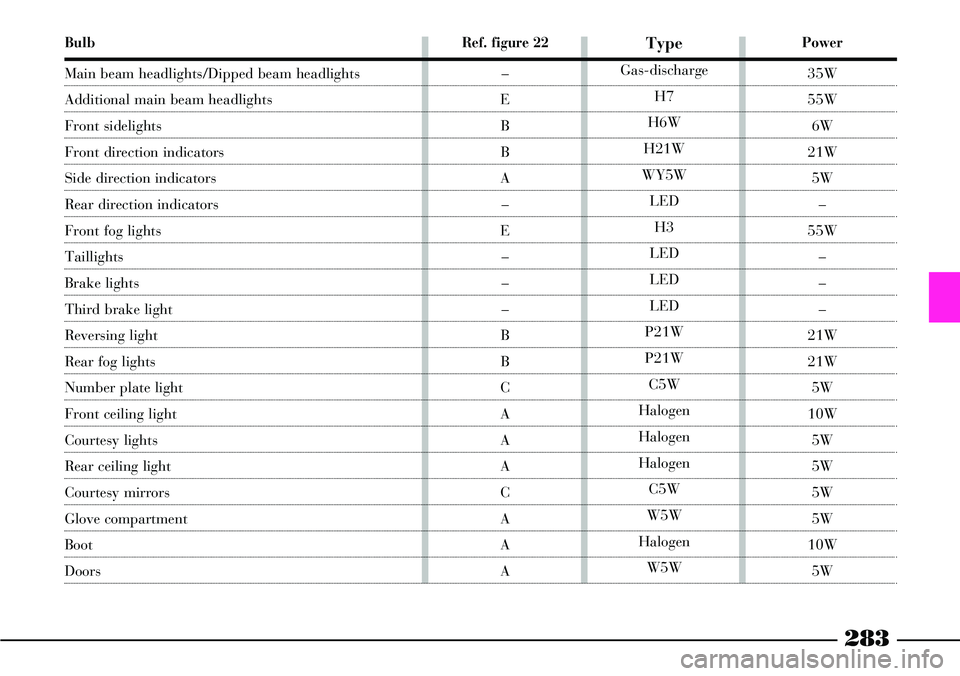
283
Bulb
Main beam headlights/Dipped beam headlights
Additional main beam headlights
Front sidelights
Front direction indicators
Side direction indicators
Rear direction indicators
Front fog lights
Taillights
Brake lights
Third brake light
Reversing light
Rear fog lights
Number plate light
Front ceiling light
Courtesy lights
Rear ceiling light
Courtesy mirrors
Glove compartment
Boot
Doors
Power
35W
55W
6W
21W
5W
–
55W
–
–
–
21W
21W
5W
10W
5W
5W
5W
5W
10W
5W
Type
Gas-discharge
H7
H6W
H21W
WY5W
LED
H3
LED
LED
LED
P21W
P21W
C5W
Halogen
Halogen
Halogen
C5W
W5W
Halogen
W5W
Ref. figure 22
–
E
B
B
A
–
E
–
–
–
B
B
C
A
A
A
C
A
A
A
Page 285 of 386

284
IF AN EXTERIOR
BULB BURNS OUT
FRONT LIGHT CLUSTER
The front light cluster includes
main beam headlights/dipped beam
headlights, additional main beam
headlights, direction indicators and
sidelights.Light layout is the following
(fig. 23):
A– Main beam headlight/dipped
beam headlight (bi-Xeno bulb)
B– Sidelight
C– Additional main beam head-
light
D– Direction indicator.Any operation on the
front light cluster must be
made with the stalk at 0
(lights off) and ignition key
removed for at least 15 minutes
(to let bulb cooling and con-
densers discharging): risk of elec-
trical discharge!
fig. 23
L0A0106b
To replace front head-
light bulbs, front light
clusters shall be removed.
It is therefore recommended to
the bulbs replaced at Lancia
Dealership.Due to high voltage, the
bulb of bi-Xeno gas-dis-
charge headlights must
only be replaced by experts: dan-
ger of death! Contact the Lancia
Dealership.
Page 297 of 386
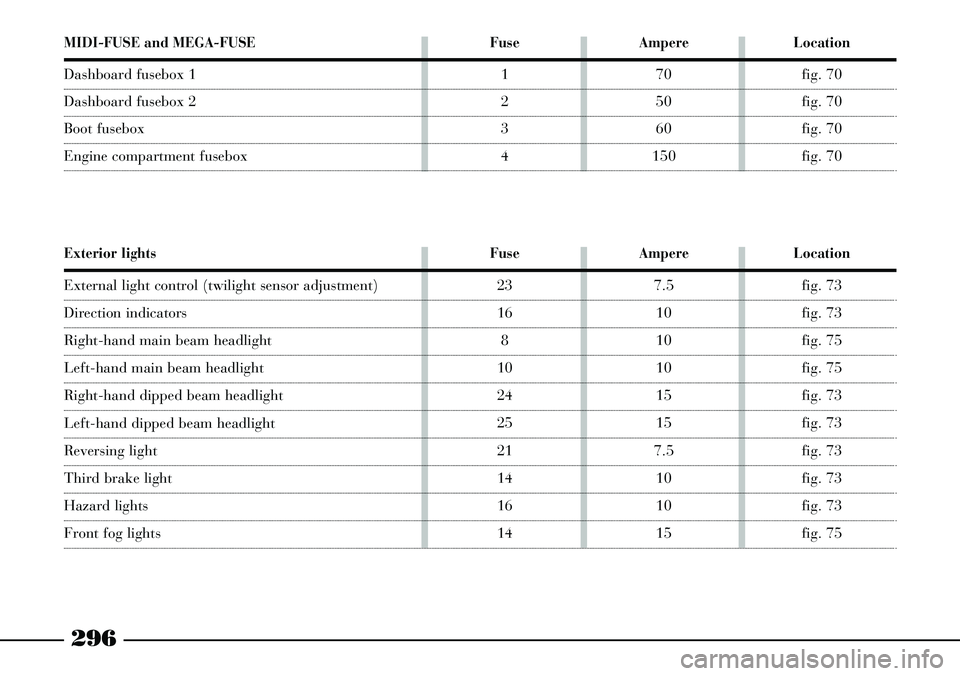
296
MIDI-FUSE and MEGA-FUSE
Dashboard fusebox 1
Dashboard fusebox 2
Boot fusebox
Engine compartment fusebox
Fuse
1
2
3
4
Ampere
70
50
60
150
Location
fig. 70
fig. 70
fig. 70
fig. 70
Exterior lights
External light control (twilight sensor adjustment)
Direction indicators
Right-hand main beam headlight
Left-hand main beam headlight
Right-hand dipped beam headlight
Left-hand dipped beam headlight
Reversing light
Third brake light
Hazard lights
Front fog lights
Fuse
23
16
8
10
24
25
21
14
16
14
Ampere
7.5
10
10
10
15
15
7.5
10
10
15
Location
fig. 73
fig. 73
fig. 75
fig. 75
fig. 73
fig. 73
fig. 73
fig. 73
fig. 73
fig. 75
Page 298 of 386
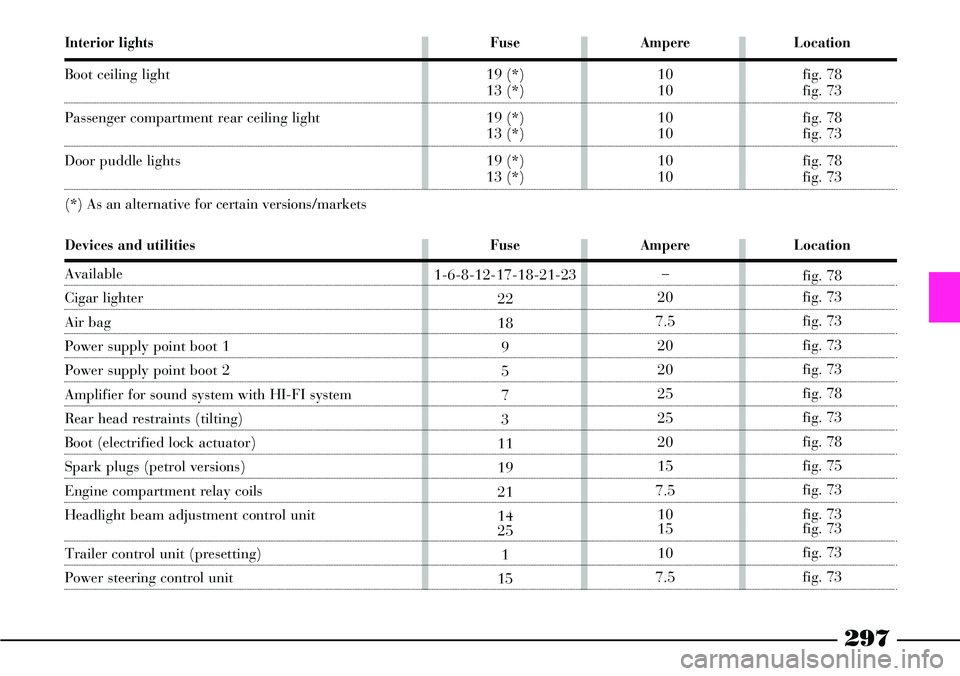
297
Interior lights
Boot ceiling light
Passenger compartment rear ceiling light
Door puddle lights
(*) As an alternative for certain versions/markets
Fuse
19 (*)
13 (*)
19 (*)
13 (*)
19 (*)
13 (*)
Ampere
10
10
10
10
10
10
Location
fig. 78
fig. 73
fig. 78
fig. 73
fig. 78
fig. 73
Fuse
1-6-8-12-17-18-21-23
22
18
9
5
7
3
11
19
21
14
25
1
15
Ampere
–
20
7.5
20
20
25
25
20
15
7.5
10
15
10
7.5
Location
fig. 78
fig. 73
fig. 73
fig. 73
fig. 73
fig. 78
fig. 73
fig. 78
fig. 75
fig. 73
fig. 73
fig. 73
fig. 73
fig. 73
Devices and utilities
Available
Cigar lighter
Air bag
Power supply point boot 1
Power supply point boot 2
Amplifier for sound system with HI-FI system
Rear head restraints (tilting)
Boot (electrified lock actuator)
Spark plugs (petrol versions)
Engine compartment relay coils
Headlight beam adjustment control unit
Trailer control unit (presetting)
Power steering control unit
Page 299 of 386

298
Devices and utilities
Horn
Windscreen wiper controls
Brake light control (NC)
Brake light control (NA)
Ignition switch
Air conditioner compressor
Cruise Control (satellite controls)
Cruise Control (Adaptive point)
Climate control system fan
Engine cooling electric fan (first)
Engine cooling electric fan (second)
Right-hand headlight (control unit)
Left-hand headlight (control unit)
Diesel fuel filter (PTC)
Electronic injection system
Injectors (diesel versions)
Driving position point interface
Automatic transmission point interface
Climate control system point interface
Fuse
11
23
20
14
7
12
20
20
5
3
4
10
10
16
13
19
14
15
23
6
15
Ampere
15
7.5
7.5
10
20
7.5
7.5
7.5
40
60
20
7.5
7.5
20
7.5
20
20
10
7.5
10
7.5
Location
fig. 75
fig. 73
fig. 73
fig. 73
fig. 75
fig. 75
fig. 73
fig. 73
fig. 75
fig. 75
fig. 78
fig. 78
fig. 78
fig. 75
fig. 75
fig. 75
fig. 78
fig. 78
fig. 73
fig. 73
fig. 73
Page 300 of 386

299
Devices and utilities
Engine control system point interface
Brake system point interface
Headlight washers
Heated rear window
Automatic gearbox starter
NIM
Passenger position point
Steering lock point
Brake Assistant point
(*) As an alternative for certain versions/markets
Braking system point (NFR 1)
Braking system point (NFR 2)
Infotelematic point
Yaw Lateral point
(*) As an alternative for certain versions/markets
Keyless System point
Driver door point
Driver door point (power supply)
Passenger door point
Fuse
22
29
15
17
17
6
14
22
19 (*)
13 (*)
19
1
6
6
19 (*)
13 (*)
19
22
11
8
11
23
Ampere
7.5
7.5
20
30
30
10
10
10
10
10
7.5
40
40
10
10
10
7.5
10
20
20
20
7.5
Location
fig. 75
fig. 73
fig. 75
fig. 73
fig. 75
fig. 73
fig. 78
fig. 78
fig. 78
fig. 73
fig. 73
fig. 75
fig. 75
fig. 73
fig. 78
fig. 73
fig. 73
fig. 78
fig. 78
fig. 73
fig. 78
fig. 73
Page 309 of 386

308
– In pile-ups on the motorway,
particularly when the visibility is
bad, there is a high risk of other
vehicles running into those already
stopped. Get out of the car immedi-
ately and take refuge behind the
guard rail.
– If the doors are blocked, do not
attempt to smash the windscreen to
get out of the car. It is made of lay-
ered glass and is very hard. Side and
rear window are much more easily
broken.
– Remove the ignition keys from
the vehicles involved.
– If you can smell petrol or other
chemicals, do not smoke and make
sure all cigarettes are extinguished.
– Use a fire extinguisher, blanket,
sand or earth to put out fires no
matter how small they are. Never
use water.
– If it is not necessary to use the car
light system, disconnect the negative
terminal (–) from the battery pole.IF ANYONE IS INJURED
Never leave the injured person alone.
The obligation to provide assistance
exists even for those not directly in-
volved in the accident
– Do not congregate around the in-
jured person
– Reassure the injured person that
help is on its way and will arrive soon.
Stay close by to calm him/her down
in case of panic
– Unfasten or cut seat belts holding
injured parties
– Do not give an injured person any-
thing to drink.
– Do not move an injured person un-
less the following situations arise
– Pull the injured person from the
car only if it risks catching fire, it is
sinking in water or is likely to fall over
a cliff or similar. Do not pull his/her
arms or legs, do not bend the head
and, as far as possible, keep the body
horizontal.IF AN ACCIDENT
OCCURS
– It is important to keep calm.
– If you are not directly involved in
the accident, stop at least ten metres
away from the accident.
– If you are on a motorway do not
obstruct the emergency lane with
your car.
– Turn off the engine and turn on
the hazard lights.
– At night, illuminate the scene of
the accident with your headlights.
– Act carefully, you must not risk
being run over.
– Mark the accident by putting the
red triangle at the regulatory dis-
tance from the car where it can be
clearly seen.
– Call for rescue making the infor-
mation you give as accurate as you
can. On the motorway use the spe-
cial column-mounted emergency
phones.
Page 315 of 386
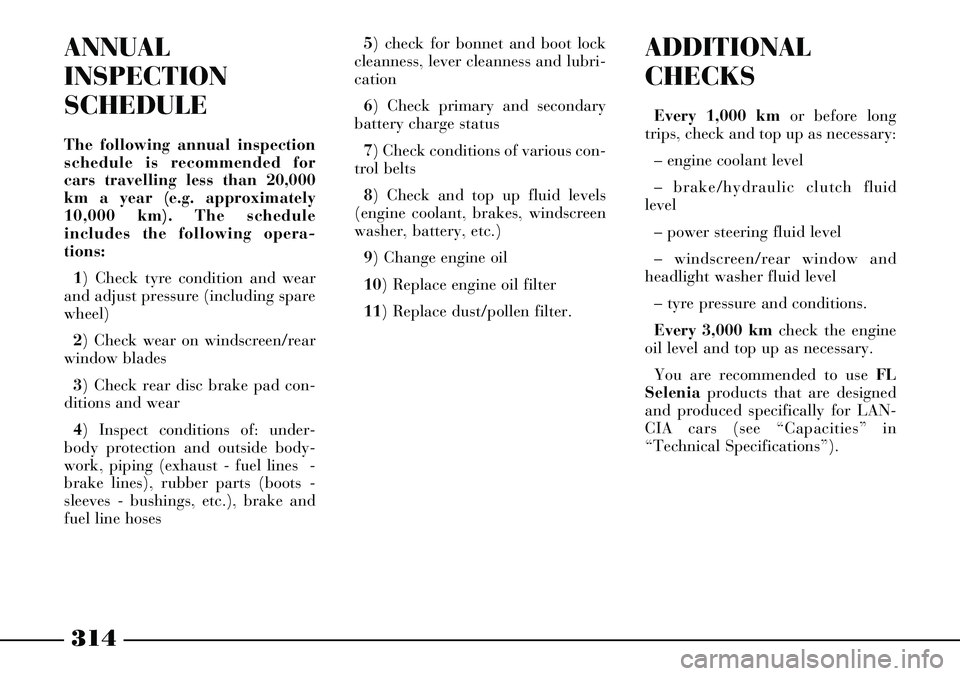
314
ADDITIONAL
CHECKS
Every 1,000 kmor before long
trips, check and top up as necessary:
– engine coolant level
– brake/hydraulic clutchfluid
level
– power steering fluid level
– windscreen/rear window and
headlight washer fluid level
– tyre pressure and conditions.
Every 3,000 kmcheck the engine
oil level and top up as necessary.
You are recommended to use FL
Seleniaproducts that are designed
and produced specifically for LAN-
CIA cars (see “Capacities” in
“Technical Specifications”).
ANNUAL
INSPECTION
SCHEDULE
The following annual inspection
schedule is recommended for
cars travelling less than 20,000
km a year (e.g. approximately
10,000 km). The schedule
includes the following opera-
tions:
1) Check tyre condition and wear
and adjust pressure (including spare
wheel)
2) Check wear on windscreen/rear
window blades
3) Check rear disc brake pad con-
ditions and wear
4) Inspect conditions of: under-
body protection and outside body-
work, piping (exhaust - fuel lines -
brake lines), rubber parts (boots -
sleeves - bushings, etc.), brake and
fuel line hoses5) check for bonnet and boot lock
cleanness, lever cleanness and lubri-
cation
6) Check primary and secondary
battery charge status
7) Check conditions of various con-
trol belts
8) Check and top up fluid levels
(engine coolant, brakes, windscreen
washer, battery, etc.)
9) Change engine oil
10) Replace engine oil filter
11) Replace dust/pollen filter.
Page 318 of 386
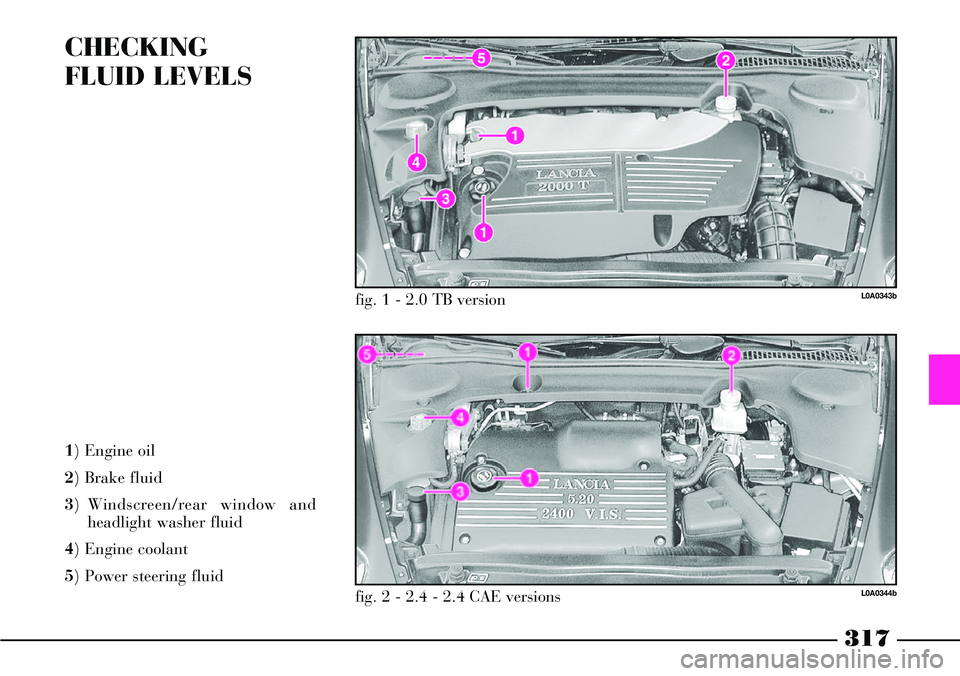
317
CHECKING
FLUID LEVELS
1) Engine oil
2) Brake fluid
3) Windscreen/rear window and
headlight washer fluid
4) Engine coolant
5) Power steering fluid
L0A0343b
L0A0344b
fig. 1 - 2.0 TB version
fig. 2 - 2.4 - 2.4 CAE versions